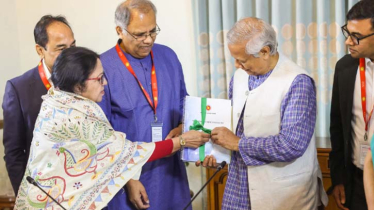
Photo : Collected
The value of taka is increasing as the price of dollar, which has been rising for the past two years, has finally begun to decline. Although banks paid up to Tk 124 per dollar for remittances only a few days ago, it has now come down to Tk 114 per dollar.
On Thursday, the dollar price was Tk 118-119 for import bill settlement, which was Tk 122-124 two weeks ago.
Apart from this, there has been a big fall in the dollar price in the open market or kerb market as well. On Thursday, it was sold at Tk 118.4 per dollar. A few months ago, the price was Tk 126-127.
According to bank officials, the supply of dollar in the market has increased due to lower import costs and increased export earnings and remittances. Due to this, dollar prices are falling. They also said if this trend continues, the dollar market will stabilise.
The country’s currency exchange rate remained stable for nearly a decade till March 2022, benefiting businesses. It had a positive impact on the macroeconomy as well.
But after the start of the Russia-Ukraine war, as the prices of goods and raw materials increased in the global market, taka started to depreciate rapidly against the US dollar. As a result, per dollar price increased from Tk 85-86 to more than Tk 120 in just a few months.
Taka continued to depreciate against the dollar despite the central bank’s implementation of multiple exchange rates across sectors, such as exports, imports, and remittances. In the last quarter of 2023, there was an unprecedented instability in the exchange rate.
However, after the January 7 elections, the market stabilised somewhat. Many banks are no longer buying dollar at high prices due to the overall reduced demand. At the same time, those who had held dollars in the hope that prices would rise also started to release those in the market, resulting in increased supply.
Money Exchange Association of Bangladesh’s President SM Zaman told The Daily Messenger, “If the supply is more than the demand, the price of any commodity will naturally fall. For quite some time now, the supply of dollar seems to be greater than the demand even in the open market. That is why the price has come down.”
Afzal Karim, chairman of Bangladesh Foreign Exchange Dealers Association (BAFEDA) and managing director of Sonali Bank, said, “Many thought the price of dollar will increase. But we said there is no reason for that. We can already see its reflection. Dollar rates have also come down in the informal market as the supply-demand gap narrows. Hopefully, it will decrease further in the future.”
According to the data of the Bangladesh Bank, at the beginning of the day on February 20, the net amount of dollar and other foreign currencies in banks was $31.2 crore. It rose to over $75 crore on March 20.
In this regard, Mezbaul Haque, executive director and spokesperson for the Bangladesh Bank, said, “The central bank has taken various steps to overcome the dollar crisis. The effects are now visible in the market. As supply increases in banks, prices also come down.”
Meanwhile, the International Monetary Fund (IMF) continued to push for the market-based price of dollar, but the Bangladesh Bank refused to accept it. The central bank has informed them that there is currently no market-based situation for dollar prices.
Several meetings were held online on Thursday between the IMF’s technical committee and the Bangladesh Bank’s special committee. The IMF believes the central bank-mediated price setting system should be left to the market. Doing so will further reduce the existing pressure on foreign exchange.
However, despite continued IMF pressure, the central bank has not moved away from its conservative stance yet. It said prices would be fixed in a controlled manner in the corridor system.
Messenger/Fameema








